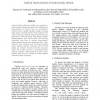Free Online Productivity Tools
i2Speak
i2Symbol
i2OCR
iTex2Img
iWeb2Print
iWeb2Shot
i2Type
iPdf2Split
iPdf2Merge
i2Bopomofo
i2Arabic
i2Style
i2Image
i2PDF
iLatex2Rtf
Sci2ools
CSB
2005
IEEE
2005
IEEE
Artificial Neural Networks to Predict Daylily Hybrids
Artificial Neural Networks (ANN) were employed to predict daylily (Hemerocalli spp.) hybrids from known characteristics of parents used in hybridization. Features such as height, diameter, foliage, blooming habit, ploidy, blooming sequence were included in the initial training and testing. Data pre-processing was performed to meet the format requirements of ANN. Backpropagation (BP), Kalman filter (KF) learning algorithms were used to develop nonparametric models between the input and output data sets. These networks were compared with traditional multiple linear regression models. Prediction plots for both height and diameter indicated that the regression model had a better accuracy in predicting unseen patterns. However, ANN models were able to more robustly generalize and interpolate unseen patterns within the domain of training.
| Added | 24 Jun 2010 |
| Updated | 24 Jun 2010 |
| Type | Conference |
| Year | 2005 |
| Where | CSB |
| Authors | Ramana M. Gosukonda, Masoud Naghedolfeizi, Johnny Carter |
Comments (0)

